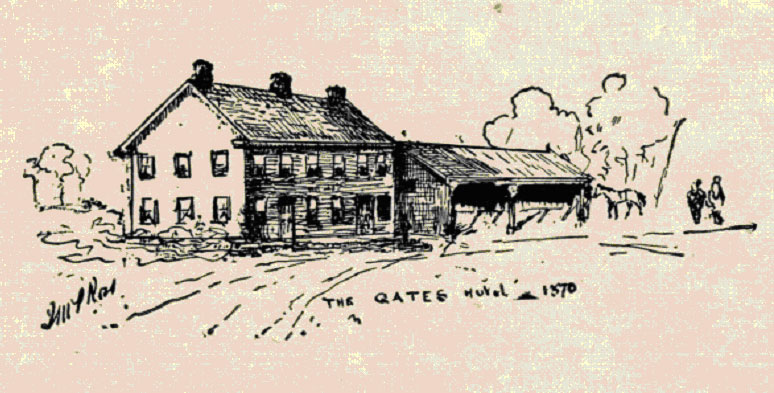Newmarket Race Course and the Gates family
Big Time Horse Racing on the Danforth, 1853 to 1912
Introduction Acknowledgements Excerpt:Danforth in Pictures
Charles Gates years, 1853 to 1872 Later years, 1872 to 1912 (coming soon)
Part 1: Charles Gates years, 1853 to 1872
Early life of Charles Gates
Charles Gates, the founder of the Newmarket Track, was one of five children of Scarborough pioneers Jonathan Gates (1795-1853), a prosperous innkeeper, farmer and land holder originally from Tyrone, Ireland, and his first wife, Hannah Cornell (1797-1827), a daughter of Loyalists from Rhode Island.
Charles’s precise birth date is unknown, but based on his age recorded in the first three Canadian censuses (compiled in 1852, 1861 and 1871), he could have been born as late as 1824, as early as 1818, or somewhere in-between, around 1822.
By the mid-1840s, Charley had married Jane Robinson of Peterborough, and moved from his native Scarborough to York Township. There. in partnership with Toronto wharf owners Richard Tinning Senior (1801-1858) and his son, Richard Tinning Junior (1825-1898), he operated the Union Race Course, which had opened in Toronto in 1842 on the east bank of the Don River south of the Kingston Road (Queen Street); the partners had taken over the track in 1846.
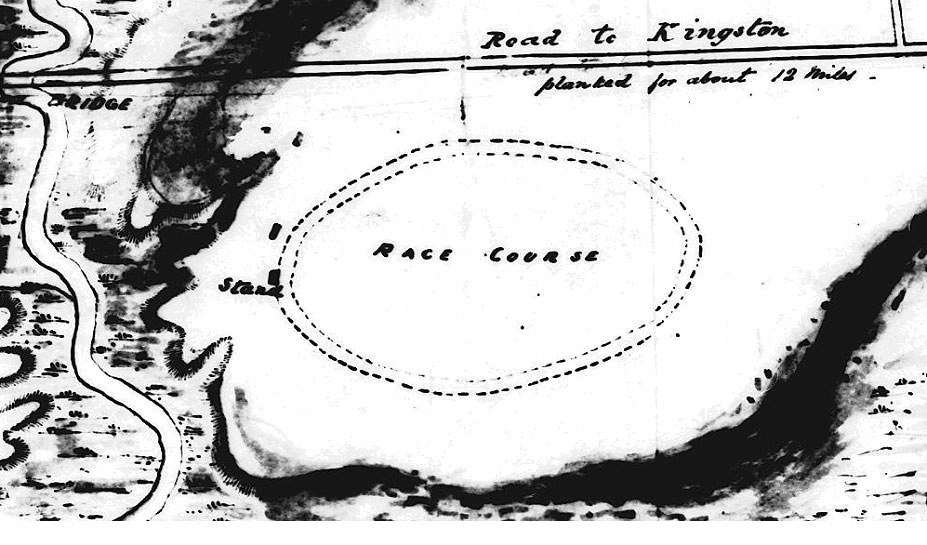
Union Race Course, 1846.
Charles Gates was one of the operators of this track, located in Toronto on the east bank of the Don River,
south of today’s Queen Street East, 1842-1852. Detail of Holloway and Boxer map, “Sketch of Toronto …”
Gates concurrently ran a tavern housed in a one-storey frame building on the north side of the Kingston Road, opposite the track. He lived there with his family, which the 1852 census recorded included the 28-year-old innkeeper, his wife Jane, age 25, and their three young daughters, Ann (six), Eliza (four) and Mary, an infant. The Union Race Course closed shortly after the end of its ten-year lease, and the last meet was held there on 21-23 September 18521.
Establishment of Newmarket Race Course, 1853
Charley Gates soon relocated to the southwest quadrant of Lot 4, Concession 2 from the Bay, 50 acres bordering the north side of the Don and Danforth Road (Danforth Avenue) between the present Oak Park and Chisholm avenues, and extending north to today’s Hamstead Avenue. Here Gates started a new track called Newmarket; the first meet was held on 30 August 1853.
Said to be the first one-mile track in Canada, the Newmarket course, was “laid out on the undulating sand and gravel hills that prevailed here,” recounted local writer, artist and politician John McPherson Ross (1851-1924) in his invaluable recollections and sketches of "Danforth Ave. in old days," published in the Toronto Evening Telegram in 19202.
“Newmarket” commemorated the famous track in England , and eventually was used for three other race courses in the province, at London, Guelph and St. Catharines. Gates also established an adjacent hotel that he named for himself. It became a popular hangout for the horsey set.
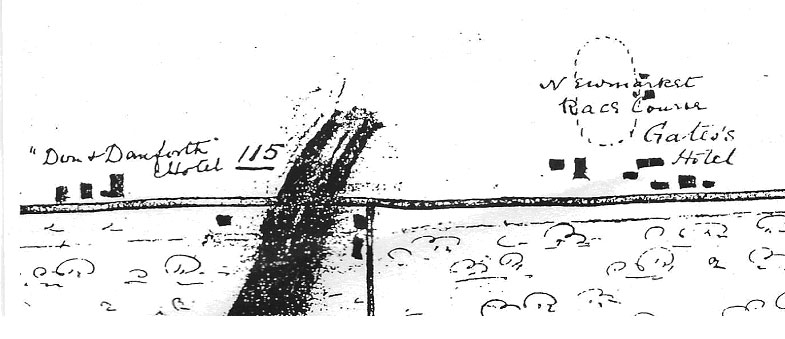
Newmarket Race Course and Gates’s Hotel, 1868
Detail of H.J.W. Gehle map,
"Sketch sheets…of the County E. of Toronto…"3
Charles had the means to acquire and develop his new property, having inherited a portion of his father’s large estate following his death on 15 January 1853. Jonathan Gates not only had owned his home farm of 300 acres in Scarborough (Lot 19 and 20, Concession C) but also additional lands in Scarborough, Whitby, Pickering and Vaughan townships, Toronto and Bronte4. The steeply sloping ravine that cuts through the Scarborough Bluffs in the vicinity of Bellamy Avenue on its way to Lake Ontario is known as Gates Gulley.
When he acquired his 50 acres on the Danforth in the early 1850s, Charley must have been aware that improved transportation services were in the works that would greatly benefit his businesses. Holloway and Boxer's sketch map of 1846 shows that the “Road to Scarborough” (now Danforth Avenue) was "planked for about 1 mile" east from its intersection with today’s Broadview Avenue5. It was not until 1851, however, that the Don and Danforth Plank Road Company was organized6. Eventually the company’s plank road extended from Don (Gerrard) Street in Toronto crossing the Don River by a new bridge built in 1856, turning north at the present Broadview Avenue and then east along today’s Danforth Avenue and Danforth Road in Scarborough, terminating at Markham Road.
Construction of the eastern section of the Grand Trunk Railway of Canada (GTR), formally incorporated in 1852, reached York Township in 1856. On 27 October 1856, the first through train, consisting of three first-class and three second-class coaches, ran from Montreal to Toronto, and a similar train made the journey in the opposite direction. The trip took 14 hours and ended at the first Don Station, located just west of the Don River. Although the GTR did not open the local York Station south of Danforth and east of today’s Main Street until 1884, it ran special trains to the Newmarket course for important races before that.
Life on the Gates farm in the 1850s and 1860s
In 1861, 39-year-old Charles Gates was a “Horse racer, tavern keeper and farmer,” the census recorded. His household now comprised wife Jane and seven children; daughters Lydia and Octavia and sons Charles Nelson (Charlie) and Albert Edward (Allie) had been born since the previous census. Three more children arrived subsequently – Charlotte (Lottie), Archibald (Archie) and Jonathan - for a total of ten, six girls and four boys.
They lived in a two-storey frame house that also served as the hotel, which had been rebuilt and enlarged with stables in 1858. It was popular for balls and banquets, as well as during racing meets. The farm was worth $10,000 in 1860 and had 24 acres of pasture, five acres of wood, and 21 acres under cultivation producing spring wheat, peas, buckwheat, beans and hay.
During Charles Gates’s tenure, he started the practice of hosting a variety of events on the property in addition to racing, training and stabling horses. Over time, these included hunting, pigeon shooting and bicycle racing.
Evidently, though, there was only one “great quoiting match,” which took place in September 1859 between clubs from Toronto and Scarborough. Charles was made an honourary member of the Scarborough club, which won the prize “a splendid silver cup, the gift of Mrs. Charles Gates,” which she presented at a “sumptuous repast” in Gates’s Hotel to the Scarborough club’s president, Alexander Muir7. Eight years later, while the schoolmaster in nearby Leslieville, Muir composed the national song, The Maple Leaf Forever, bringing him lasting fame.
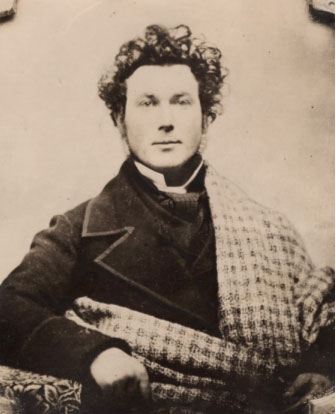
Alexander Muir (1830-1906), about 1855.
Muir was the captain of the Scarborough team that defeated Toronto
to win the “great quoiting match” at the Newmarket course in September 1859.
Horse racing at the Newmarket course and the Queen’s Plate
Charley Gates’s first love was horse racing. Possessing an “irascible temper,” the “veteran Canadian horseman” was “a power on the turf and it took fast horses and keen judgement to get the better of him,” claimed E. (Edmund) King Dodds in his 1909 book, Canadian turf recollections and other sketches. Dodds included several anecdotes about Gates that other writers have repeated over the years8.
The Toronto Turf Club sometimes held its races at the Newmarket course. Started in 1837 as the Upper Canada Turf Club, it had been “recently reorganized” when “the Newmarket (Gates’) race course, Don and Danforth Road” was the site of its well-attended races on 5 and 6 July 1867, a few days after Canada’s confederation. In a detailed report, the Toronto Globe assessed: “It is but fair to assume that the club can obtain a better and more favourable spot for their periodical meetings.” Facilities at the Newmarket course included a grand stand – "a structure requiring some attention," - the Globe noted, an adjoining stewards’ stand with a ladies’ balcony, as well as the track itself:
The Toronto Turf Club was instrumental in the establishment of the Queen’s Plate in 1860. “It was hoped that securing a sizeable purse – specifically one with royal prestige – would encourage breeders from the United States or Great Britain to bring quality horses to Canada,” David Wencer explained in his blog, Toronto’s Horse Racing History. “Thus, in 1859, the Toronto Turf Club petitioned Governor General Edmund Walker Head for an annual horse racing prize to be awarded by Queen Victoria. Victoria granted a plate of 50 guineas, and the Queen's Plate was first held the following June.”
The first four Queen’s Plates were held at the Carleton Race Track, under the auspices of the Toronto Turf Club. Located near what is now the southwest corner of Keele Street and Humberside Avenue, the Carleton track was a rival with Newmarket and, it was claimed in 1868, the former "is much more level than its counterpart on the eastern side of the City"10. The next four Plates were at various tracks around the province, but the ninth running was at “Gates’ Track” on 17 June 1868.

Advertisement for the Toronto Races at the Newmarket Course, Toronto Globe, 25 May 1868.
The Queen’s Plate was to be the third race on the first day, Wednesday, 17 June 1868.
John McPherson Ross, then a teenager living in Leslieville, vividly recalled the race was "rather remarkable for several reasons. One, being the very hot weather … the thermometer ranging around the 100 mark for days. The officers of the 13th Hussars ran the meeting under their auspices11 and the wealth and fashion of Toronto was there in full force and the crowds of soldiers made rather a brilliant scene with their scarlet and blue tunics, also the smart uniforms of the Artillery were conspicuous as a regular battery was here then as well.12"
The Daily Leader reported that the Newmarket race attracted the "most intense interest, not only in Toronto, but all over the country." It was estimated that up to 12,000 people watched the race, described as the biggest Plate crowd ever.
All available vehicles at various livery stables were eagerly secured, and horses for rent at ten dollars a day were all gone by noon; nags that should have been left in the pasture were pressed into duty. Despite the GTR running a special train and adding extra cars, men and women were clinging to the tops of the cars for the ride home.
The music of the Twenty-ninth Regiment band enlivened the ceremonies and refreshment booths offered food and drink. Spectators posed a disruption to the start of the Plate race, resolved as Colonel John Jenyns ordered about 20 of his Hussars on horseback to clear the track.
The race consisted of two laps around the one-mile track. The field contained 15 horses, the largest number yet. Nettie (later called Nellie), a five-year-old bay filly owned and bred by James and John White of Halton County, was the winner by a neck. The horse’s sire and dame were both foaled in Upper Canada, making her a true Canadian-bred horse. She was the first Plate-winning mare to produce a future champion, Fanny Wiser, who in 1882 won the Queen’s Plate at London.
In the small world of Canadian horse racing, Charles Gates’s family would have further connections with the 1868 Queen’s Plate. In 1873, fifth daughter Octavia Cecilia Gates (1856-1887) married Archie Fisher, the winning jockey, and he lived on the Newmarket property shortly before his death in 187813. Second son Albert Edward (Allie) Gates (1860–1922) was the jockey aboard Fanny Wiser in 1882; she was trained by William Owen, who ran the Gates hotel in the late 1880s, known by then as the Bay View Hotel.
At one time considered "the best rider in Canada,"14 Allie Gates started as a jockey at age 11, a year or so before his father died. He went on to become the first jockey to win three Queen’s Plates: aboard King George at London in 1878 when he was a substitute jockey and "a complete stranger to the horse"15; Moss Rose at Picton in 1879 and, as mentioned above, Fanny Wiser at London in 1882. His record stood until 1900. Allie later trained horses for such prominent owners as William Hendrie of Hamilton and Toronto’s Robert Davies’ Thorncliffe stable. He also owned his own string of horses, which he raised with much success, including several Queen’s Plate contenders. When he died on 13 May 1922 at age 62, he was called "one of the best-known horsemen in Canada"16.
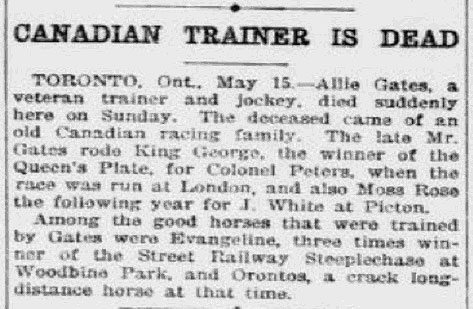
Obituary for Allie Gates, Daily Racing Form, 16 May 1922 Allie’s third Queen’s Plate win on Fanny Wiser was not mentioned in this obit.
The three other Gates sons - Charles Nelson Gates (1858–1913), Archibald Arthur Gates (1868–1911) and Jonathan Adolphus Gates (1870-1901) – also embarked on careers as horsemen, first as jockeys and then, as they grew older and heavier, trainers. Like their grandfather and father, Charlie and Archie also became hoteliers. For about seven years starting in October 1901, Charlie ran the family’s hotel on Danforth Avenue and he later bought a place in Mount Forest, Ontario. Archie purchased the Queen’s Hotel in Whitby in 1911 and operated it from April until his death in December of that year.
Charles Gates had his own Queen’s Plate winner at Whitby in 1870, John (often called Jack) Bell, which he trained but owned with his brother, Nelson Gates (1818-1890), a Scarborough farmer who bred prize-winning horses17. The race attracted 10,000 people including John Sandfield Macdonald, then the premier of Ontario. There was no bookmaking or para-mutuels at that time, only auction mutuels called pool-selling. Being the under-dog, John Bell sold for $5 in the pools of $50 and $60. Gates refused to support his horse in the pools, and even advised his young friend George H. Ham: "Bet on any one but Jack Bell. Such is perversity of youth that I immediately placed my money on Jack."18
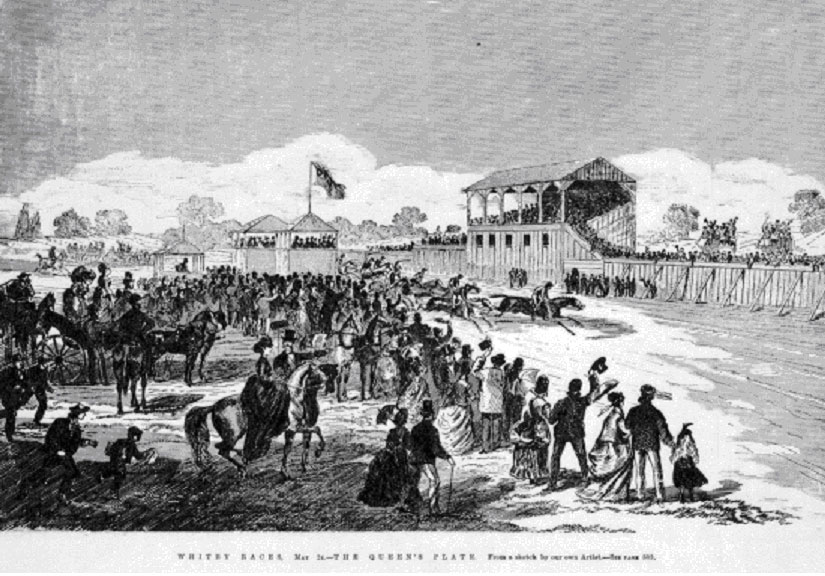
"Whitby Races, May 24. The Queen's Plate," 1870
John Bell, the winning horse, was owned by Charles Gates and his brother, Nelson Gates.
The Gates horse went on to beat the favourite by almost a length, and once a “foul” claim was dismissed by the three judges, good fortune came to all those who had put up $5 on John Bell. Considered by Ham to be “one of the memorable races of the early days”, the event was recalled more than 40 years later in the Toronto Globe.
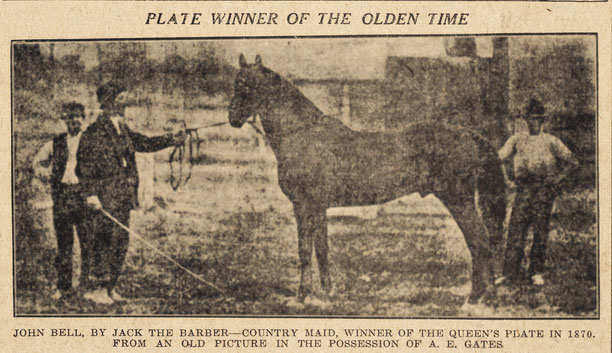
John Bell, Queen’s Plate winner in 1870,
owned by Charles Gates and Nelson Gates
Toronto Globe, 21 May 1913, p. 12
The Toronto Hunt Club, established in 1843 and celebrating its 175th anniversary in 2018, was a frequent guest on the Gates property over the years. Closely connected with the Toronto Turf Club in its early days - "in nearly all respects one and the same with the Hunt Club"19 - it often held its annual steeple-chase races at the Newmarket course. “The assemblage was unusually large and highly respectable” at the November 1871 meeting, the Globe reported. "The course included a long stretch of ploughed land, quite sufficient to test the endurance of the horses and the judgement of their riders. The remainder of the distance was over the track which is somewhat hilly.20" Charles Gates entered his Queen’s Plate winner, John Bell, in the free handicap race, but she came last of the three entries.
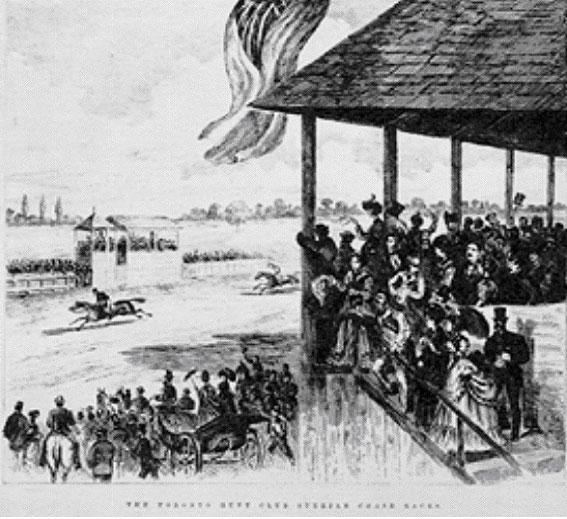
“The Toronto Hunt Club Steeple Chase Races”, November 1870
Pictured here are Toronto Hunt Club’s races at Carleton Race Course.
The scene would have been similar when its races were held at the Newmarket track in 1871.
Final years of Charles Gates, 1871-1872
In April 1871, the Canadian census recorded that 53-year-old Charles Gates was a “hotel keeper,” Ontario-born of Irish origin and an adherent of the Church of England. He headed a large household comprising wife Jane (age 46) and nine of their ten children - five daughters and four sons - whose ages ranged from 22-year-old Ann Jane to Jonathan Adolphus, an infant of ten months, as well as a horse trainer and a servant. The next three youngest Gates children, Albert (ten), Mary (six) and Archibald (three) attended school, “taught by a governess in the home,” the census noted. Thirteen-year-old Charles no longer was at school and probably had started to work as a jockey.
Charles Gates’s last race was at his own funeral on a cold winter day in 1872. We are told that the horses pulling the hearse to the family plot at Highland Creek almost ran away when the driver got down to warm himself by walking alongside.21
Endnotes
- United Empire, 13 September 1852, 3.
- J. McPherson Ross, “Danforth Ave. in old days,” Toronto Evening Telegram, 23 December 1920, 20.
- Sketch sheets of a winter Reconnaissance of the County E. of Toronto, between the Don R.; & the Township of Scarboro on the E. & the Don & Danford Rd. on then to the Lake Shore. Office Copy - original to Montreal, 20 Apl. 68. H.J.W. Gehle, Lt. R.E. 17/Apl. 68. [cartographic material].
- www.newtorontohistorical.com/1878 Family History.htm
- W. C. E. Holloway and Edward Boxer, Sketch of Toronto shewing the Harbor & the relative positions of its present & proposed Defences (1846) [http://maps.library.utoronto.ca/dvhmp/maps.html]
- Ontario, Legislative Assembly, Journals, vol. 10 (1851), Appendix 3.
- “Great quoiting match--Toronto vs. Scarboro',” Toronto Globe, 13 September 1859: 2.
- Charles “Horses” Ayers, “Took horseman ‘for a ride’ with ash gathering mare,” Toronto Star, 2 January 1932, p. 12; Louis E. Cauz and Beveley A. Smith, The Plate, 150 years of royal tradition from Don Juan to Eye of the Leopard, (Toronto: ECW Press, 2009), 37.
- “Toronto Turf Club first day’s races,” Toronto Globe, 6 July 1867, p. 2.
- “Toronto Hunt steeple-chase,” Toronto Globe, 13 November 1868, p. 4.
- The 1868 Queen’s Plate at Newmarket was under the auspices of the Toronto Turf Club, but members of the Hussars were in attendance and helped maintain order.
- Ross, “Danforth Ave. in old days,” Toronto Telegram, 23 December 1920, 20. Ross also recalled the “mix-up with the boys from Leslieville and a group of young Britons where Coxwell and Gerrard is now.”
- “Death of Mr. Archie Fisher,” The Canadian gentleman's journal and sporting times, Vol. 6, 15 February1878, p. 4..
- Toronto Star, 7 May 1908, p. 9
- Quoted by Cauz and Smith, The Plate, 37.
- “’Allie Gates dies suddenly,” Toronto Globe, 15 May 1922, 18.
- At the Provincial Agricultural Association’s annual exhibitions held in Toronto, Nelson Gates won first prize for Country Maid in the thorough-bred mare and foal category in 1862, and first prize for the best two-year-old filly and second prize for the best yearling colt in the blood horse category in 1866. A member of Christ Church, Scarborough, his death certificate noted, “Very well to do and good to the poor” when he died of old age on 10 February 1890.
- Quoted by Cauz and Smith, The Plate, p. 53.
- “Toronto Hunt steeple-chase,” The Globe, 13 November 1868: 4.
- “Toronto Hunt steeple-chase,” The Globe, 6 November 1871, 4.
- J. McPherson Ross, “Danforth Ave. in old days,” Telegram, 23 December 1920, 20.



